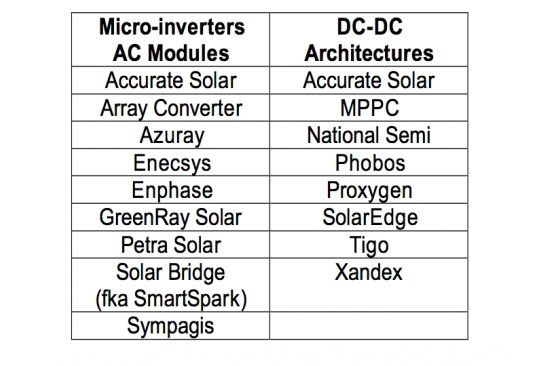Petra Solar, armed with $54 million in venture capital raised over the last three years, has built itself into a distributed generation firm leveraging microinverter and grid availability technology with a unique product and sales channel. Up until now, the startup has been relatively secretive about its affairs.
Through information garnered from our informants in bars and pool halls, we've been able to write about the firm (see here) and we even placed them in our list of the Top 50 Greentech Startups by virtue of their volume shipments and utility contract with PSE&G. That profile prompted the startup to contact Greentech Media to clarify just what it is that Petra Solar does.
Playing in the crowded microinverter/distributed inverter market involves competing against incumbent centralized inverter firms like SMA and SatCon as well as the small army of startups in this emerging field. Here's a list of the aspirants in the microinverter / distributed inverter market:
I spoke with Petra's VP of Strategic Development, Neel Master, a former investor, researcher and entrepreneur. Master believes that Petra is differentiated in this field by virtue of, amongst other things, the ten patents they hold in the field of power electronics, originally invented with NASA and the U.S. Air Force in mind. Here's a link to one of the firm's patents.
With a history of designing for the rigors of spaceflight and a portfolio of power control patents, Petra was able to get a system designed and out the door for testing by utilities relatively quickly. According to Master, utility expectations for reliability were regularly exceeded and BP Solar's stress tests yielded "great results."
Technology aside, Petra has exploited an untapped sales channel and unique application -- solar panels that are mounted on utility and power poles and sold directly to the utility. Petra has won a large contract with Public Service Electric & Gas, New Jersey's biggest power utility, to install solar panels on streetlights and power poles across the distribution network. PSE&G looks to install 200,000 panels and about 5 percent are up so far, according to PSE&G.
The company's CEO, Shihab Kuran, has claimed, "This is the single largest distributed installation in the world," according to The Star-Ledger.
Petra sells a kitted system consisting of a solar module, an integrated microinverter, mounting hardware, and wireless monitoring equipment. It sells this system directly to utilities for mounting on the distribution pole or streetlight pole. It's meant to be installed by a utility crew in less than 30 minutes and to deliver AC power directly to the grid. By dealing with utilities and mounting directly on the utility-owned pole, the hassles of permitting and Nimbyism are pretty much avoided.
Petra has partnered with SunTech and BP Solar. But they are essentially vendor- and technology-agnostic.
In Neel Master's words, "We build a self-contained energy generation system."
Unlike the other successful microinverter startup, Enphase Energy, which focuses on residential and commercial solar installations, Petra Solar looks at their solution "with the utility in mind" and "the impact of the system on the grid." It's not just about the power being generated by the Petra microinverter -- Petra is monitoring in real-time the voltage and current at each power pole. The microinverter thus serves as an element in the smart grid, alerting utilities to outages and voltage sags via wireless communications. Typically, voltage sags, which can cause brownouts, are only detected via a truck roll.
And in what is a victory for any startup, Petra is starting to ship in volume with 15,000 units delivered so far and expectations of shipping 70,000 units in 2010. The firm is commissioning about one megawatt per month and all of the units are assembled in New Jersey.
This potential for this untapped application is immense -- there are hundreds of millions of power poles in the U.S.
This type of installation lets utilities address ambitious Renewable Portfolio Standards (RPS) quickly without having to deal with siting, permitting and limited transmission resources. In fact, Petra was shipping product within a month of signing the PSE&G contract. And installation of these modules is straightforward, especially when you're working with a workforce of linesmen who know their way around power poles.


